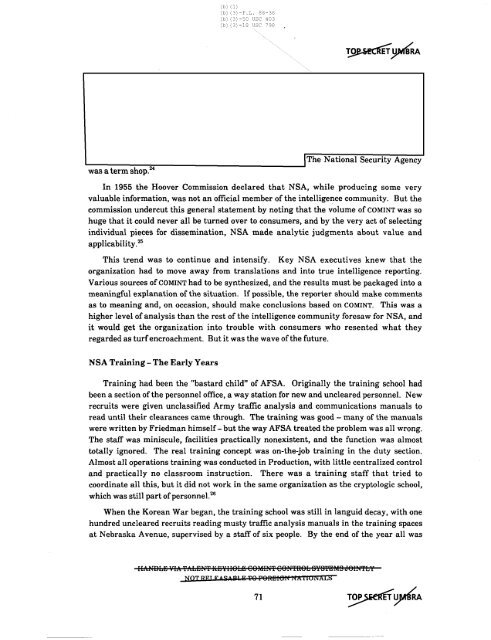American Cryptology during the Cold War - The Black Vault
American Cryptology during the Cold War - The Black Vault
American Cryptology during the Cold War - The Black Vault
Create successful ePaper yourself
Turn your PDF publications into a flip-book with our unique Google optimized e-Paper software.
Ib) (1)<br />
Ib) (3) -P.L. 86-36<br />
Ib) (3) -50 USC 403<br />
1" ,,,,) ~,,)) .•..•......<br />
'--_-:-_---:-:-"'Q'A<br />
was a term shop.24<br />
---J1<strong>The</strong> National Security Agency<br />
In 1955 <strong>the</strong> Hoover Commission declared that NSA, while producing some very<br />
valuable information, was not an official member of <strong>the</strong> intelligence community. But <strong>the</strong><br />
commission undercut this general statement by noting that <strong>the</strong> volume of COMINT was so<br />
huge that it could never all be turned over to consumers, and by <strong>the</strong> very act of selecting<br />
individual pieces for dissemination, NSA made analytic judgments about value and<br />
applicability.25<br />
This trend was to continue and intensify. Key NSA executives knew that <strong>the</strong><br />
organization had to move away from translations and into true intelligence reporting.<br />
Various sources ofCOMINT had to be syn<strong>the</strong>sized, and <strong>the</strong> results must be packaged into a<br />
meaningful explanation of <strong>the</strong> situation. Ifpossible, <strong>the</strong> reporter should make comments<br />
as to meaning and, on occasion, should make conclusions based on COMINT. This was a<br />
higher level of analysis than <strong>the</strong> rest of <strong>the</strong> intelligence community foresaw for NSA, and<br />
it would get <strong>the</strong> organization into trouble with consumers who resented what <strong>the</strong>y<br />
regarded as turfencroachment. But it was <strong>the</strong> wave of<strong>the</strong> future.<br />
NSA Training- <strong>The</strong> Early Years<br />
Training had been <strong>the</strong> "bastard child" of AFSA. Originally <strong>the</strong> training school had<br />
been a section of<strong>the</strong> personnel office, a way station for new and uncleared personnel. New<br />
recruits were given unclassified Army traffic analysis and communications manuals to<br />
read until <strong>the</strong>ir clearances came through. <strong>The</strong> training was good - many of <strong>the</strong> manuals<br />
were written by Friedman himself- but <strong>the</strong> way AFSA treated <strong>the</strong> problem was all wrong.<br />
<strong>The</strong> staff was miniscule, facilities practically nonexistent, and <strong>the</strong> function was almost<br />
totally ignored. <strong>The</strong> real training concept was on-<strong>the</strong>-job training in <strong>the</strong> duty section.<br />
Almost all operations training was conducted in Production, with little centralized control<br />
and practically no classroom instruction. <strong>The</strong>re was a training staff that tried to<br />
coordinate all this, but it did not work in <strong>the</strong> same organization as <strong>the</strong> cryptologic school,<br />
which was still part ofpersonnel. 26<br />
When <strong>the</strong> Korean <strong>War</strong> began, <strong>the</strong> training school was still in languid decay, with one<br />
hundred uncleared recruits reading musty traffic analysis manuals in <strong>the</strong> training spaces<br />
at Nebraska Avenue, supervised by a staff of six people. By <strong>the</strong> end of <strong>the</strong> year all was<br />
I1MfBbfil VIA 'fAbfilN'f ItEiY II8 I::Ei 08MIN'f 08N'fR8I:: SYS'fBlIIS of8IN'fLY<br />
NOT REI FAS un.Ji: 1'9 F8Rf!JI6fof 1'4 A IIONALS<br />
71
















